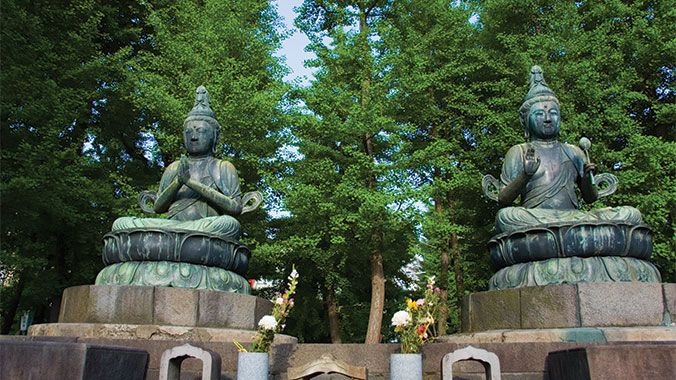
Japan
The Best of Japan: A Contrast in Tradition and Innovation
Program No. 23294RJ
Venture south from Tokyo to Hiroshima for an in-depth dive into traditional and modern Japan and learn the local history that shaped its modern society.
Enroll with Confidence
We want your Road Scholar learning adventure to be something to look forward to—not worry about. Learn more
Protecting the Environment
We offset a portion of the emissions created by your travel. Learn more
14 days
13 nights
23 meals
12B 6L 5D
1
In Transit to Program
In Flight
2
Arrive Tokyo, Check-in
Tokyo
13
Himeji Castle, Osaka
Osaka
14
Free Time, Program Concludes
In Flight
At a Glance
As an island nation, Japan’s culture is intriguingly different from its Asian neighbors. No one else in the world blends traditional lifestyles with cutting-edge technology quite like the Japanese, truly creating a belief system all their own. On this educational adventure, learn alongside expert instructors as you explore both modern cities and ancient villages to gain a deeper understanding of the Japanese perspective and the complex history behind how it was formed.
Activity Level
Keep the Pace
Plan to walk an average of 5 miles over the course of each day during visits, many that are accessed by public transportation. Travel by bullet train between cities.

Small Group
Love to learn and explore in a small-group setting? These adventures offer small, personal experiences with groups of 13 to 24 participants.
Best of all, you’ll…
- Immerse yourself in the local way of life in Ise-Shima as you stay at a family-owned Japanese hotel.
- Experience a delicious, traditional Japanese dinner with entertainment from a Maiko in Kyoto.
- Contemplate humanity in these turbulent times as you explore Hiroshima's Peace Memorial Park
General Notes
Program includes independent time to explore the city and several meals on your own. Group Leaders will provide directions for self-directed excursions. Suggestions for free-time activities provided in preparatory materials.
Featured Expert
All trip experts

John Hundleby
John Hundleby is a New Zealander who has lived and worked in Japan for more than 30 years. He and his Japanese wife have chosen to settle permanently in Japan in order to be close to their two children and five grandchildren. His work in Japan included roles as a New Zealand diplomat and, latterly, as a representative for, and promoter of, the New Zealand beef and lamb sector. Those roles afforded him the opportunity to appreciate the charms of many parts of Japan.
Please note: This expert may not be available for every date of this program.

John Hundleby
View biography
John Hundleby is a New Zealander who has lived and worked in Japan for more than 30 years. He and his Japanese wife have chosen to settle permanently in Japan in order to be close to their two children and five grandchildren. His work in Japan included roles as a New Zealand diplomat and, latterly, as a representative for, and promoter of, the New Zealand beef and lamb sector. Those roles afforded him the opportunity to appreciate the charms of many parts of Japan.

Kumi Yasui
View biography
A native of the Tokyo area, Kumi Yasui is a Japanese Nationally-Certified Guide. In additional to her leading work in the Mie prefecture, she is heavily involved in the Japanese National Guide Association. Kumi moved to Mie when her businessman husband was persuaded by his parents to return home with an eye to taking over the family's Buddhist temple. She and her husband have two young children.
Suggested Reading List
(8 books)
Visit the Road Scholar Bookshop
You can find many of the books we recommend at the Road Scholar store on bookshop.org, a website that supports local bookstores.
The Best of Japan: A Contrast in Tradition and Innovation
Program Number: 23294
Culture Smart! Japan
A quick guide to the customs and etiquette of Japan.
Kitchen
The first novel of one of Japan's contemporary literary stars to be translated in to English.
The Tale of Genji
Completed in the early 11th century, Genji Monogatari is considered a masterpiece of Japanese prose literature, and one of the world's earliest novels. Although its exact origins remain elusive, it is believed that the female author spent many years in service to the royal family of the time.
Super Sushi Ramen Express: A Culinary Adventure Through Japan
A fascinating and funny culinary journey through Japan. Japan is arguably the preeminent food nation on earth; it's a mecca for the world's greatest chefs and has more Michelin stars than any other country. The Japanese go to extraordinary lengths and expense to eat food that is marked both by its exquisite preparation and exotic content. Their creativity, dedication, and courage in the face of dishes such as cod sperm and octopus ice cream are only now beginning to be fully appreciated in the sushi- and ramen-saturated West, as are the remarkable health benefits of the traditional Japanese diet.
A Traveller's History of Japan
A history of Japan and its transformation from Shinto, Shogun and Samurai traditions to 20th-century powerhouse.
Rice, Noodle, Fish: Deep Travels Through Japan's Food Culture
An innovative new take on the travel guide, Rice, Noodle, Fish decodes Japan's extraordinary food culture through a mix of in-depth narrative and insider advice, along with 195 color photographs. In this 5000-mile journey through the noodle shops, tempura temples, and teahouses of Japan, Matt Goulding, co-creator of the enormously popular Eat This, Not That! book series, navigates the intersection between food, history, and culture, creating one of the most ambitious and complete books ever written about Japanese culinary culture from the Western perspective.
Hiroshima
First published in 1946, this recounts the events of August 6, 1945 through the observations of survivors.
Embracing Defeat: Japan in the Aftermath of World War II
This monumental work by America's foremost historian of modern Japan traces the impact of defeat and reconstruction on every aspect of Japan's national life. Alongside the familiar story of economic resurgence, Dower examines how the nation as a whole reacted to the contradictory experiences of humiliation at the hands of a foreign power and liberation from the demands of a suicidal nationalism.




















